FEBRUARY 17, 2010 — In seventh grade, my well-meaning middle-school teachers created a disaster of a lesson plan they called “The Indian Unit,” which combined one part worthwhile history lessons, one part Native American theme park, and one part White Man’s Guilt. During that stretch of ill-conceived Native American-themed school days, I remember learning about Native American history in geography class, reading about the offensiveness of NFL team mascots in literature class, and calculating the volume of a teepee in math class. When we did something in school that a teacher liked, he gave us plastic wampum beads which we were to keep on a hokey necklace. As a special treat one day, the teachers gathered two hundred twelve year olds in the library and forced us to watch the full 240-minute version of Dances With Wolves, the gratuitous length of which almost killed all of us. The Indian Unit’s grand finale was something the teachers called “Grand River Day”: we went on a field trip to a local Ohio State park and tried to hunt rabbits by sending an impregnable line of kids to walk across a field and flush out the bunnies. Then we ate moose stew, a concoction that I’m pretty sure was made with beef from the local grocery store. I was a cynical tween, and I can’t remember another two-month long stretch of my life during which I rolled my eyes more.
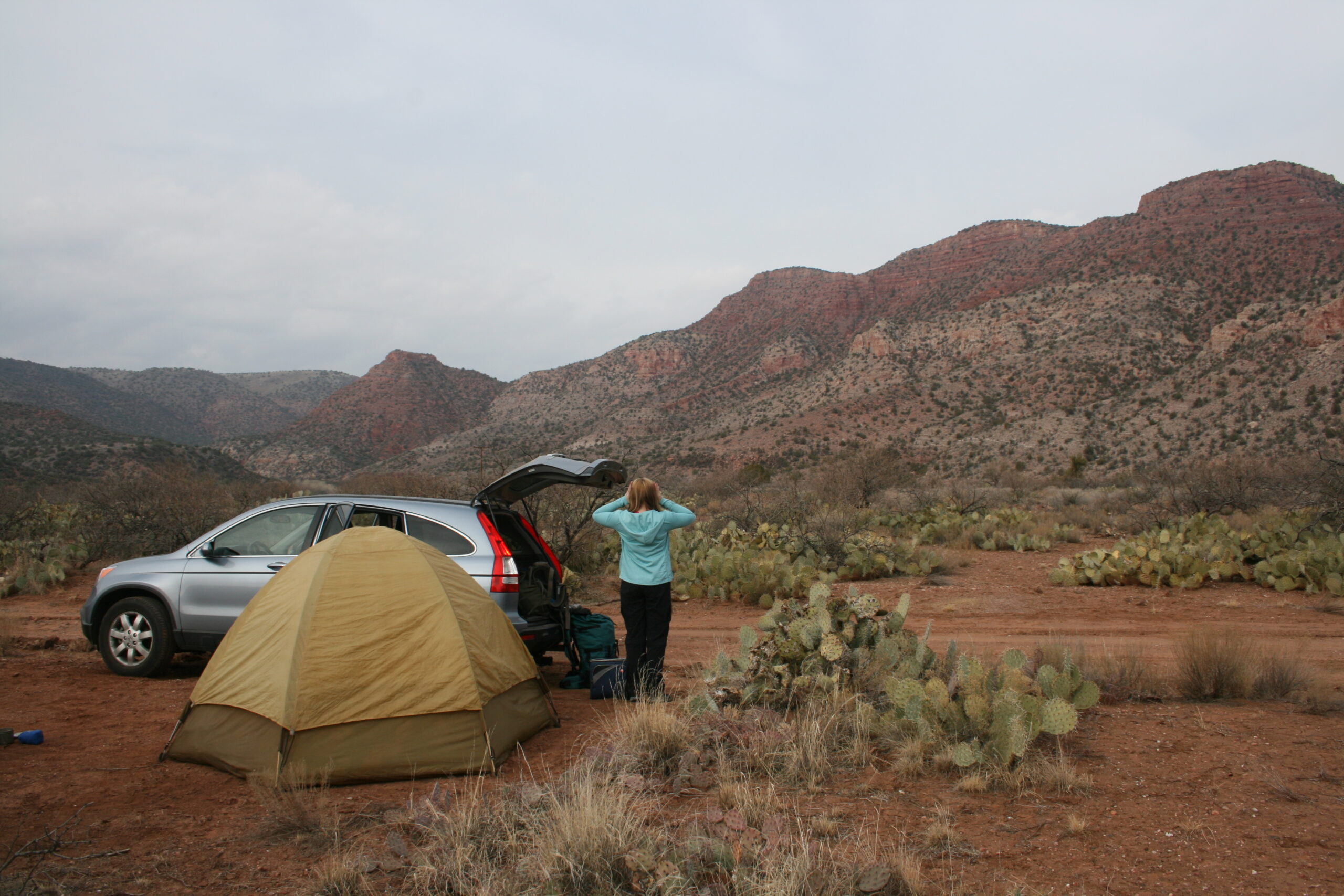
The group gets ready for a hike into Sycamore Canyon to find a Verde Hohokam cliff dwelling.
Last year, when my friend Wini, visiting from Switzerland, begged me to take her in my car on an Indian ruins road trip, all I could think about was ridiculous plastic wampum necklaces and four hours of Kevin Costner’s face. If my middle school teachers’ goal was to leave me with positive feelings about Native American history, they had failed miserably. And, since Wini and I had so many good ideas for our great Western road trip, the proposed Native-American-history-road-trip idea eventually fell by the wayside.
Yet, the idea of the trip stayed in my head, long after Wini’s return to Switzerland.
“It’s time for an Indian ruins road trip!” I pronounce to my friends Rich, Wendy, and Vik, about four months later. To my surprise, they agree to accompany me with enthusiasm; fortunately, they never endured the Indian Unit.
Soon, the four of us are driving toward Arizona in the night. I have appointed myself the car’s annoying middle school teacher.
“About seven hundred years ago, around AD 1300, thousands of Native Americans, living among the beautiful red and orange mesas, buttes, and hoodoos of what is now the Four Corners region of the American Southwest, disappeared,” I announce to my companions, synthesizing information as I gather it from Ancient Ruins of the Southwest: An Archaelogical Guide. Apparently, exposure to Native American history as an adult transforms me into a whimsical Indiana Jones/Mr. Wizard hybrid. “No one knows exactly why these tribes — the Hohokam, the Anasazi, and the Sinagua — decided to abandon the area, though archaeologists suspect that a drought, food shortages, overcrowding, disease, and foreign invasion may have been factors.”
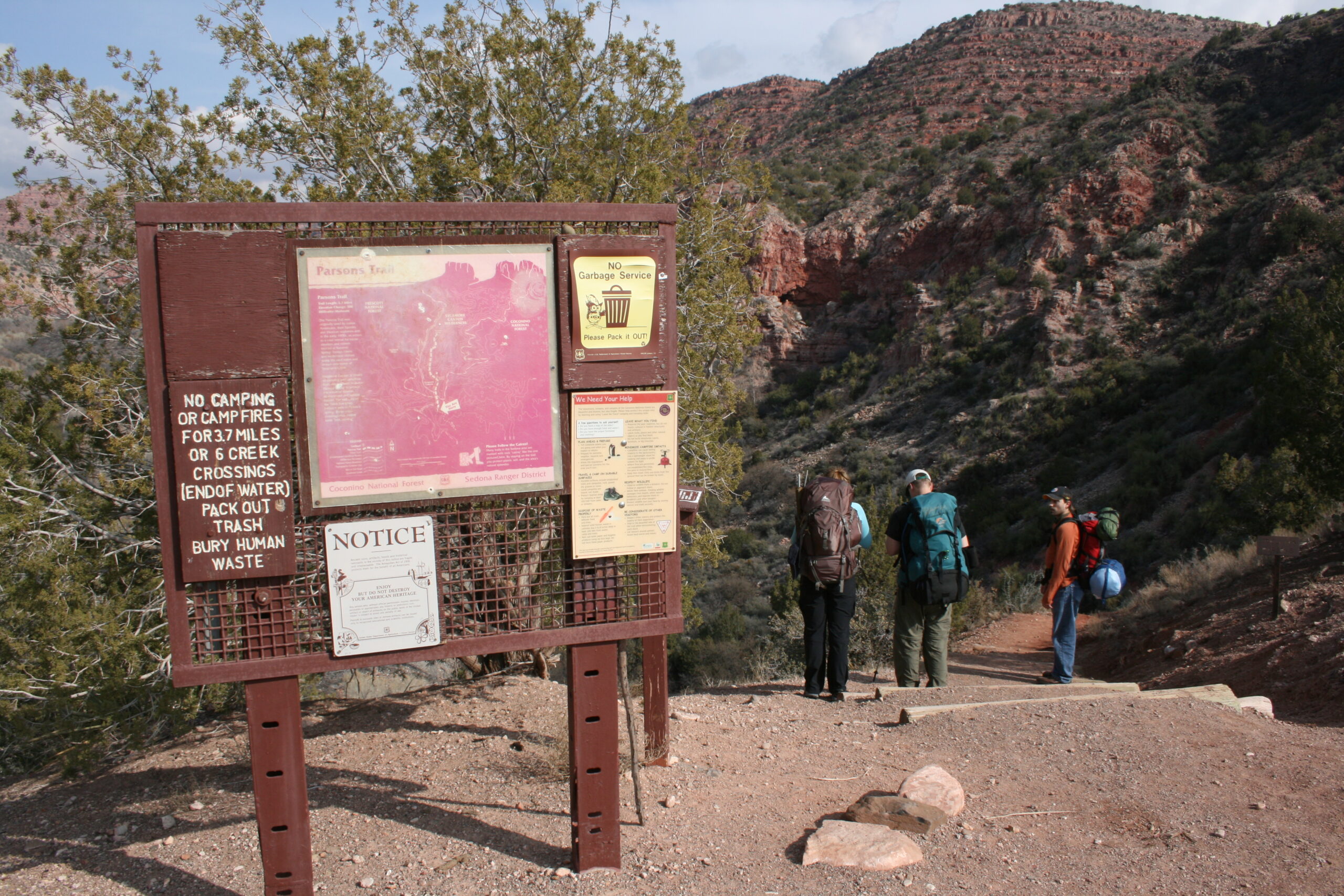
The Sycamore Canyon hike trailhead sign
“You’re like an educational human Podcast,” Wendy groans as she rolls her eyes.
“When can we stop for a cigarette?” Vik asks.
“Wait, we’re getting to Arizona at 3 AM and getting up at 6 AM? And we’re doing this every day? To look for people who disappeared 700 years ago?” Rich asks me, bewildered.
I realize that I, too, must have been annoying to my middle school teachers.
“Well, not exactly,” I say. “The Hohokam, Anasazi, and Singuaga people from 1300 have been gone for centuries.” But there is something about the idea of a “real” Indian Unit — one that replaces Kevin Costner and fake moose stew with the actual ruins of Native American civilizations — that has caught my imagination. I hope that, maybe, we’ll see clues helping to explaining the mysterious disappearance of these tribes. Maybe I can do better than my middle school teachers.
“Well, we can sleep in a little bit on the first morning,” I explain, knowing that we’re trying to fit a ten-day road trip into four days so that we can work around everyone’s work schedules.
When we arrive in middle-of-nowhere Arizona near the supposed site of some remote ruins after driving from Los Angeles for eight hours, we’re all deliriously tired. So we’re not sure we trust our eyes, when, while driving down a dirt road into the pitch-black Sycamore Canyon Wilderness, our headlights reveal a strange animal in the darkness that we can’t identify. We stop the car and stare at its eerie appearance, confused.
“It’s a cow,” Wendy says.
“No, cows don’t look like that,” Rich says. “It’s a wolf.”
“Maybe it’s a wolfcow,” I suggest.
I think of a Navajo legend about skinwalkers, people who have gained the supernatural ability, by performing a horrible act of evil (such as killing a family member), to turn into any animal they choose. According to the legend, skinwalkers often manifest themselves as wolves, and there’s a ranch in Utah where many, along with UFOs and poltergeists, allegedly have been sighted. I don’t mention the legend to anyone in the car, because, well, who wants to hear about an unbelievable myth from a grating, faux middle school teacher?
We drive a few more feet, when suddenly, a glimmering white horse appears in front of the car. Seriously. No one says anything.
“I think it’s time to set up camp and go to sleep,” I say. But I’m thinking that we’ve only been on our Indian ruins road trip for eight hours, and, already, I feel like we’re kicking the butts of my old teachers. My middle school Indian Unit never made me feel like I had become entangled in a surreal Native American dream.
Becoming Indiana Jones
Discovering ancient Indian ruins on the steep rim of Arizona’s Sycamore Canyon.
FEBRUARY 18, 2010 — After sleeping in on the first morning of our Indian ruins road trip, I wake up confused, trying to remember if the wolfcow and white horse from the night before actually existed or were simply images from a dream. Wendy, Rich, Vik, and I repack our backpacks and begin hiking the fourteen mile trip toward Verde Hohokam cliff-dwelling ruins purportedly hidden high on a ridge in the Arizona wilderness. As we make our way up steep Sycamore Canyon toward flat Packard Mesa, Wendy says that she can’t believe that the Verde Hohokam would build their homes so far from everything. But as soon as she says it, we realize together that that in the Verde Hohokam’s world, one without roads, cars, and maps, there was no concept of “everything.” The cliff dwelling we’re hiking toward was probably as close to “everything” as anywhere.

A cliff dwelling built by the Verde Hohokam sits on the rim of Sycamore Canyon in Arizona.
Quickly, we find ourselves off-trail (due to a sketchy path and a vague description in our trail guide), and we hike through a dangerous obstacle course of cacti that we dub “Cactus Pass.” As we search for the trail, I slip and fall onto a purple cactus, which gleefully deposits a bunch of spines in my leg that feel like burning needles. I’m embarrassed when we’re forced to bring the hike to a halt so that Wendy can use tweezers to remove a bunch of particularly painful spines from my thigh. But soon, we’re scaling 500 feet up a ridge toward what we think is the location of the cliff dwelling. When we reach the top of one side of the Canyon’s rim, we walk toward the supposed GPS coordinates of the ruins, only to find that we’re blocked by a cliff and a 1,000 foot drop below us. We don’t see any ruins. As the sun begins to set, I realize why my middle school teachers chose a safe, local state park for Grand River Day.
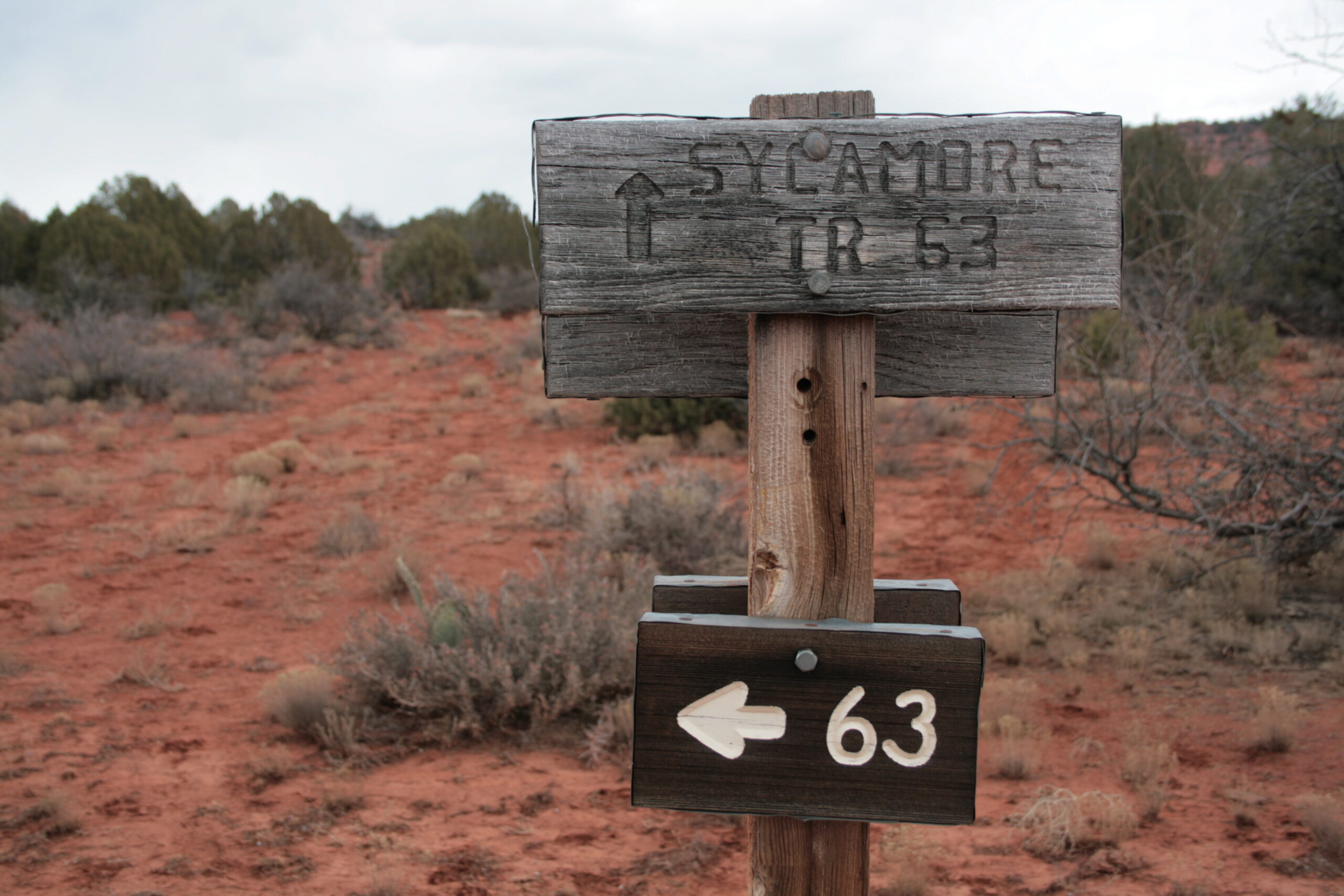
An exceptionally confusing trail sign near Sycamore Canyon, Arizona.
“I know we’re very, very close!” I insist, hoping we can continue in the dark. Wendy takes the role of a responsible teacher and reminds us that we can continue searching again in the morning.
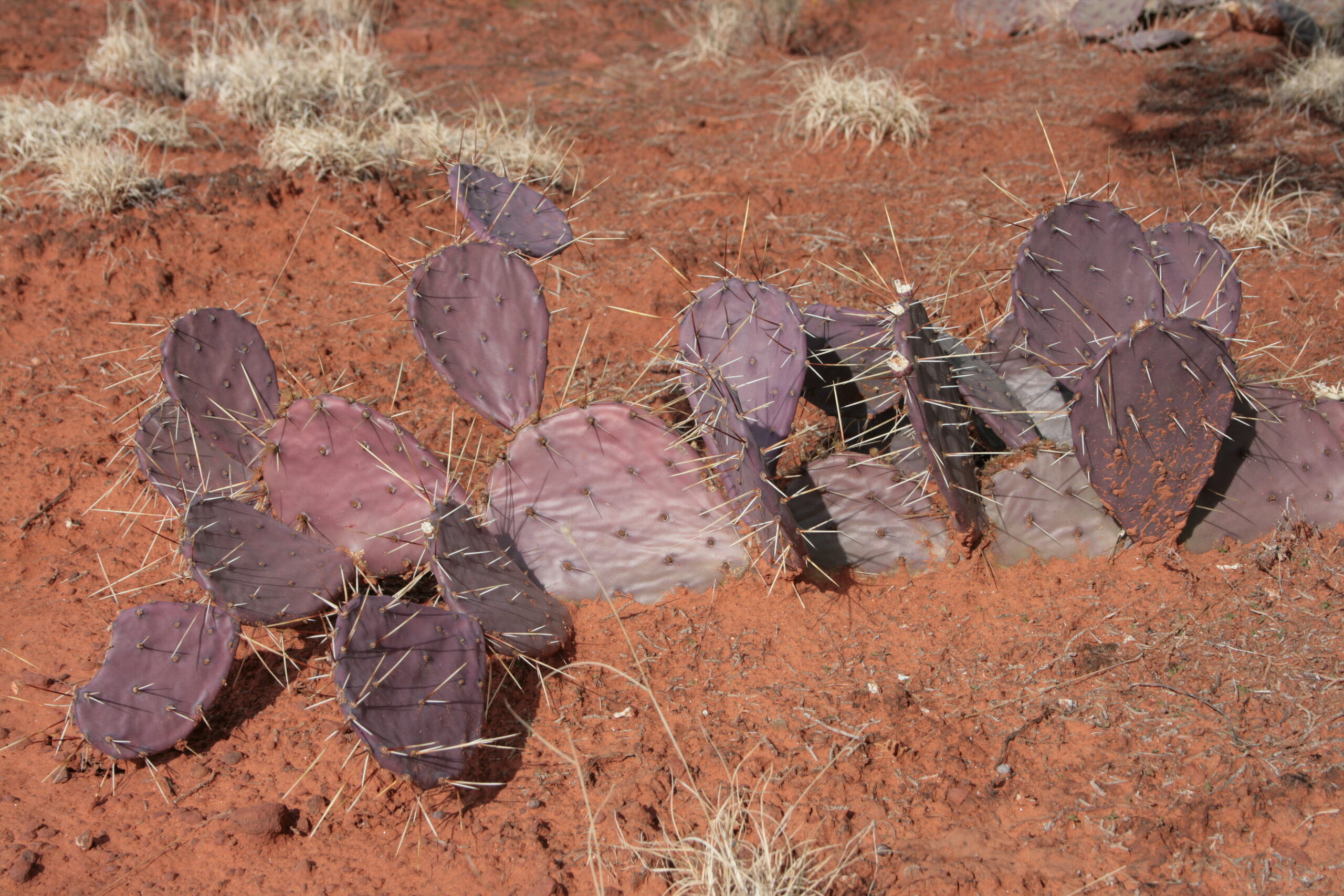
Cacti in the Arizona desert can be surprisingly dangerous, especially if you make the mistake of falling on one palm first.
Unable to sleep after setting up camp, I spend an hour in my tent studying the topographical map on my GPS device and realize that the ruins’ actual site is located high up on the steep face of the Canyon lip opposite the one on which we’re camped. I decide that we’re going to have to shuffle our way around the precarious Canyon’s edge to get there. At sunrise, we begin hiking again, precariously making our way around the rim, inching slowly toward what we believe to be the site of the ruins, hidden behind a curve in the rock and a towering plateau. The climbing over crumbling red sandstone and dangerous cacti as we snake our way around becomes too perilous for Rich and Vik, and they decide to stay behind. But Wendy and I continue on, eventually dropping our packs to creep forward more easily.

Wendy scales a sandstone ridge toward the rim of Sycamore Canyon.
“We’re totally like Indiana Jones!” I yell right before embarrassing myself again by falling, this time palm-first, on top of another purple cactus. When I look at my hand, impaled by about twenty cactus spines, I start to grow skeptical that anyone would build a house requiring a seven-mile, uphill climb through deadly cacti every day after work (which, I suppose, for the Verde Hohokam, meant hunting and gathering food). Just as I’m about to declare that the ruins’ supposed coordinates must be wrong, I see that my GPS device reports that only 200 yards remain until we reach our target.
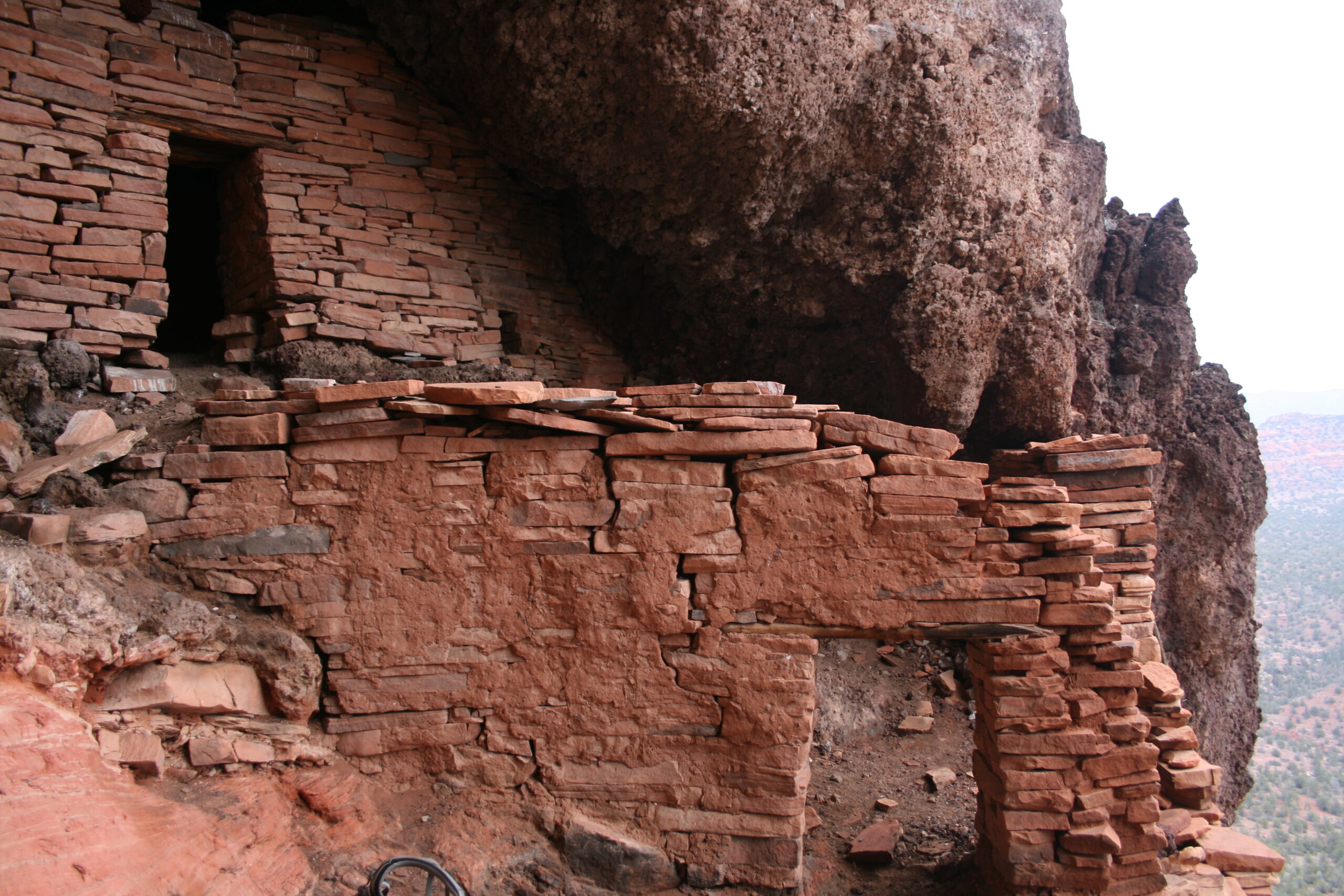
Verde Hohokam cliff dwelling ruins sit near the rim of Sycamore Canyon in Arizona.
“Two football fields!” I yell back to Wendy. “If we don’t see the ruins there, we’re turning around.”
But soon, as we claw our way up a smooth sandstone incline, I see the ruins of a dwelling, made of orange sandstone bricks, towering above us under a large cliff.
“I’ve found the ruins!” I yell, trying to sound as much as possible like Indiana Jones. I wish I were wearing a wide-brimmed fedora. As I continue scrambling toward the cliff dwelling from far below, I discover the imprint of a trail that would have made our approach much easier. When we reach the cliff-dwelling, Wendy and I take a quick look around and then rush back to retrieve Rich and Vik so that we can escort them back on the newly discovered trail.
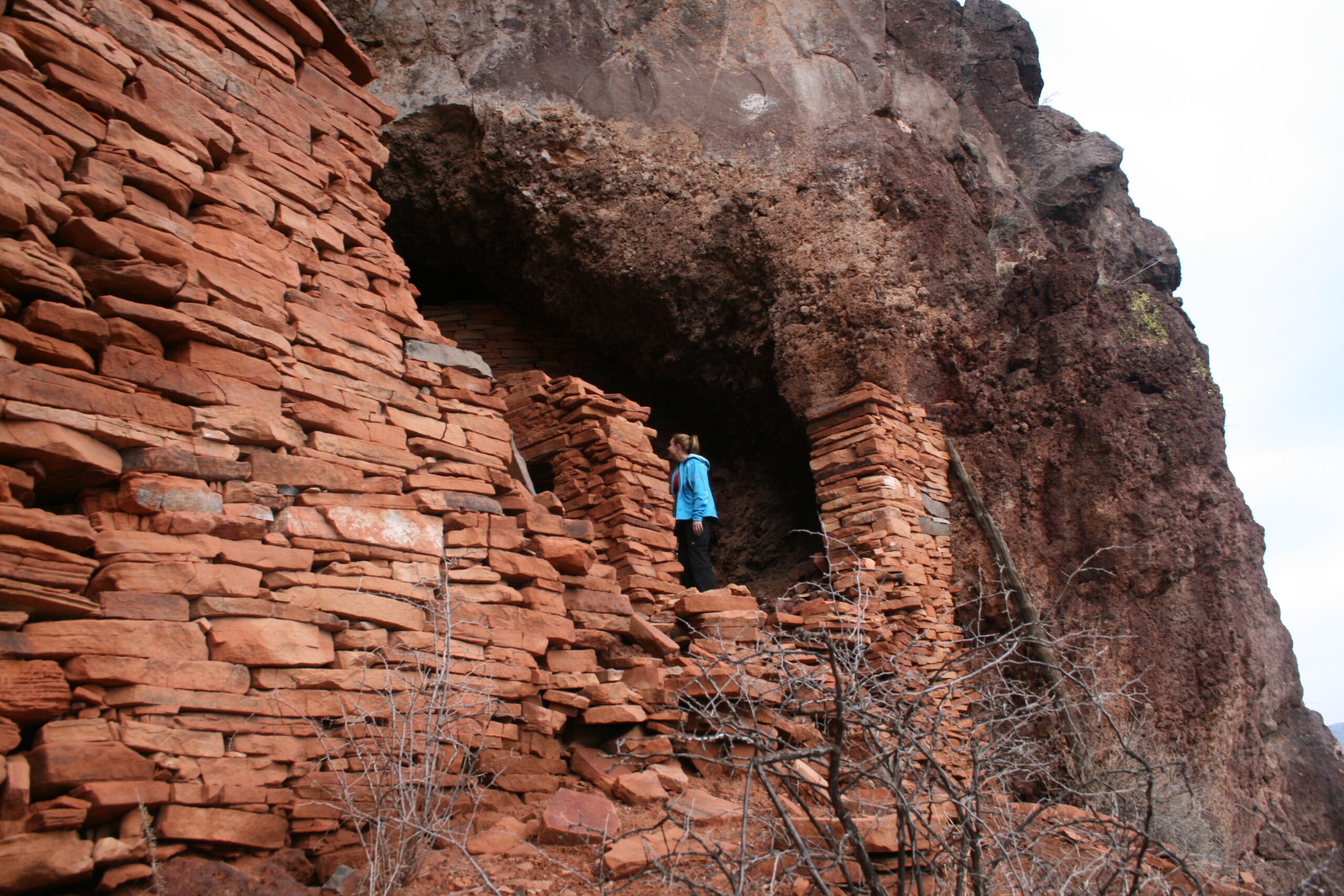
Wendy explores Verde Hohokam cliff dwelling ruins.
When the four of us finally arrive at the ruins together, we look out at the grand expanse of Sycamore Canyon’s floor, over 1,000 feet below us. The impressive view makes me wonder whether the Verde Hohokam built their home in such an inaccessible location for the same reason that movie stars build mansions on the top of cliffs in Malibu, California. I can’t suppress my excitement and again start acting like a nerdy middle school teacher, reciting more facts from our archaeological guide.

A view of Sycamore Canyon as seen from Verde Hohokam cliff dwelling ruins near the Canyon’s rim.
“Archeologists believe that Indians positioned hilltop ruins sites atop high ridges, in sight of each other, intentionally, so that they could to communicate over long distances using smoke signals,” I explain. I’m excited to discover that our book suggests that my great-view theory is partly accurate. “At one time, it was possible for Native Americans to make line-of-sight contact using these hilltop lookout posts from the Phoenix area to the Grand Canyon’s South Rim.”
I look out at the horizon, half expecting to see smoke signals or a magical wolfcow with a glistening white horse, revealing to us why Native Americans disappeared from here seven hundred years before. But all I see are the remarkable red and orange buttes and plateaus of central Arizona.
I realize that there’s a part of me wishing that one of my middle school teachers were actually with us. They always seemed to have the answers.
Snowpocalypse!
A blizzard interrupts a visit to Canyon de Chelly National Monument.
FEBRUARY 20, 2010 — We spend the next two days on a whirlwind tour of Indian ruins sites managed by the National Park Service. First, we hurry to nearby Montezuma Castle National Monument, an impressive Sinagua 20-room cliff dwelling overlooking the Verde Valley. We learn that the Europeans who discovered the Sinagua ruins in the 1860s assumed incorrectly that the ruins had been constructed by Montezuma and the Aztecs, and the Monument’s name is a misnomer. We start calling the ruins “Montezuma Castle (No Relation.)”

Wendy readies a snowball for snowmageddon.
“I feel like a tourist,” Rich says disappointedly. We’re all staring at a National Park diorama depicting a scene of Sinagua living in the cliff dwelling, complete with a blind man being led around by his wife and a misbehaved child running around on a mud roof. The diorama’s “Audio-Program” sign and activation button looks like it time traveled to us from 1950.
I, too, feel less like Indiana Jones in Raiders of the Lost Ark and more like Clark Griswold in National Lampoon’s Vacation. It’s significantly more rewarding finding ruins hidden on the rim of an obscure Canyon than visiting a castle and diorama at the end of a path paved by the National Park Service. Montezuma Castle (No Relation) seems like moose stew made with grocery store beef.
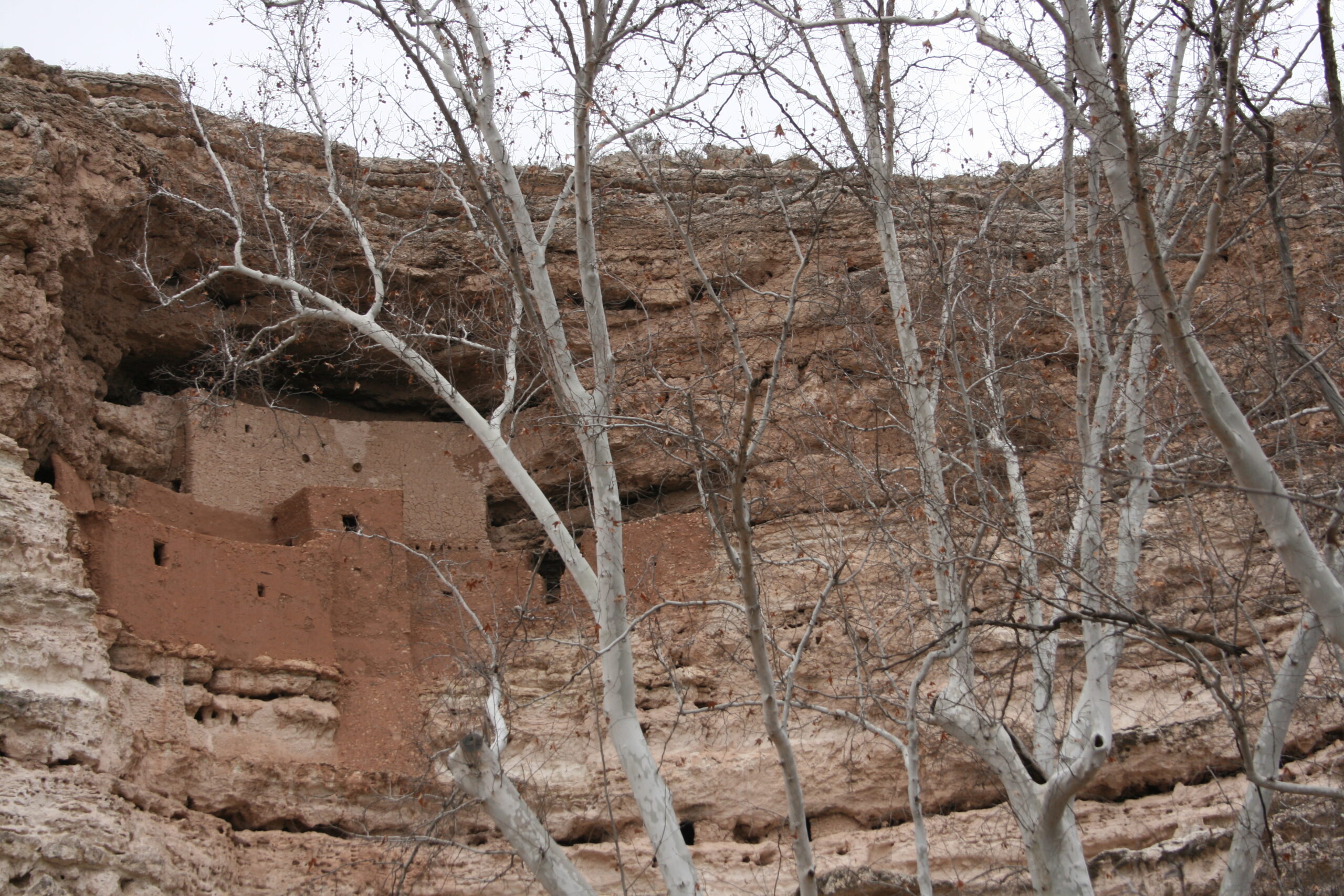
Montezuma Castle (No Relation)
We catapult ourselves during the night toward northeastern Arizona’s Canyon de Chelly National Monument, and at 7 AM, we begin hiking into the Canyon on the White House Ruins Trail. Unfortunately, it’s the only trail visitors are permitted to hike without paying a Navajo guide, due to a special arrangement between the Park Service and the Navajo Nation. Though the temperature is below freezing, we take our time enjoying the Canyon’s fantastic scenery: towering red rock mesas, mint-colored Cottonwood trees, snow covered valleys, and buttes made of stretched orange sandstone. There’s some not-so-attractive scenery too. At the bottom of the Canyon, we pass a pile of trash, lawn chairs, and jeep tracks left by previous tourists before we arrive at the White House Ruins. The chain link fence that keeps us far from the cliff dwelling punishes us for the misdeeds of our looting ancestors in 1900.

A hiker walks on a snowy ridge above Canyon de Chelly.
“The Anasazi built these cliff dwellings in the Canyon between AD 700 to 1200. Then, they mysteriously disappeared,” I, in middle-school-teacher mode, tell the group.
“Yes, yes, we know,” Wendy says. “But where the hell did they go?”
Kids today, I think.
We stand at the fence, staring at the ruins. My eyes run over the aging, cracked red rock and the dwelling’s strangely small windows. I see a few pictographs etched into the rock: one that looks like an alien wearing a condom on his head, and another that looks like a planet from another galaxy. I wonder whether the Anasazi were abducted by strange, condom-wearing aliens or were in fact aliens themselves. I don’t share any of my absurd theories with the group.

A view of Canyon de Chelly National Monument
As we hike back to the Canyon’s rim, snow starts to fall. The oversized, cottony flakes come slowly at first, sprinkling our clothes and eyelashes. The air turns quiet, in the way that it always does during heavy snowfalls, and the sky and air become white and opaque. By the time we’re near the top of the Canyon, we’re walking through a full-fledged snowstorm.
“That may have been one of the most beautiful things I have ever seen,” Vik says about the storm as the four of us, covered in snow, pile back into the car.
By the time we get to the entrance to Mesa Verde National Park in Colorado, we’ve been driving through what seems like an enormous bale of cotton for six hours. I learn from my iPhone that the media is calling the storm Snowpocalypse 2010. We’re surprised to encounter a closed, locked gate, and a Park Ranger stops us when we try to drive around it.
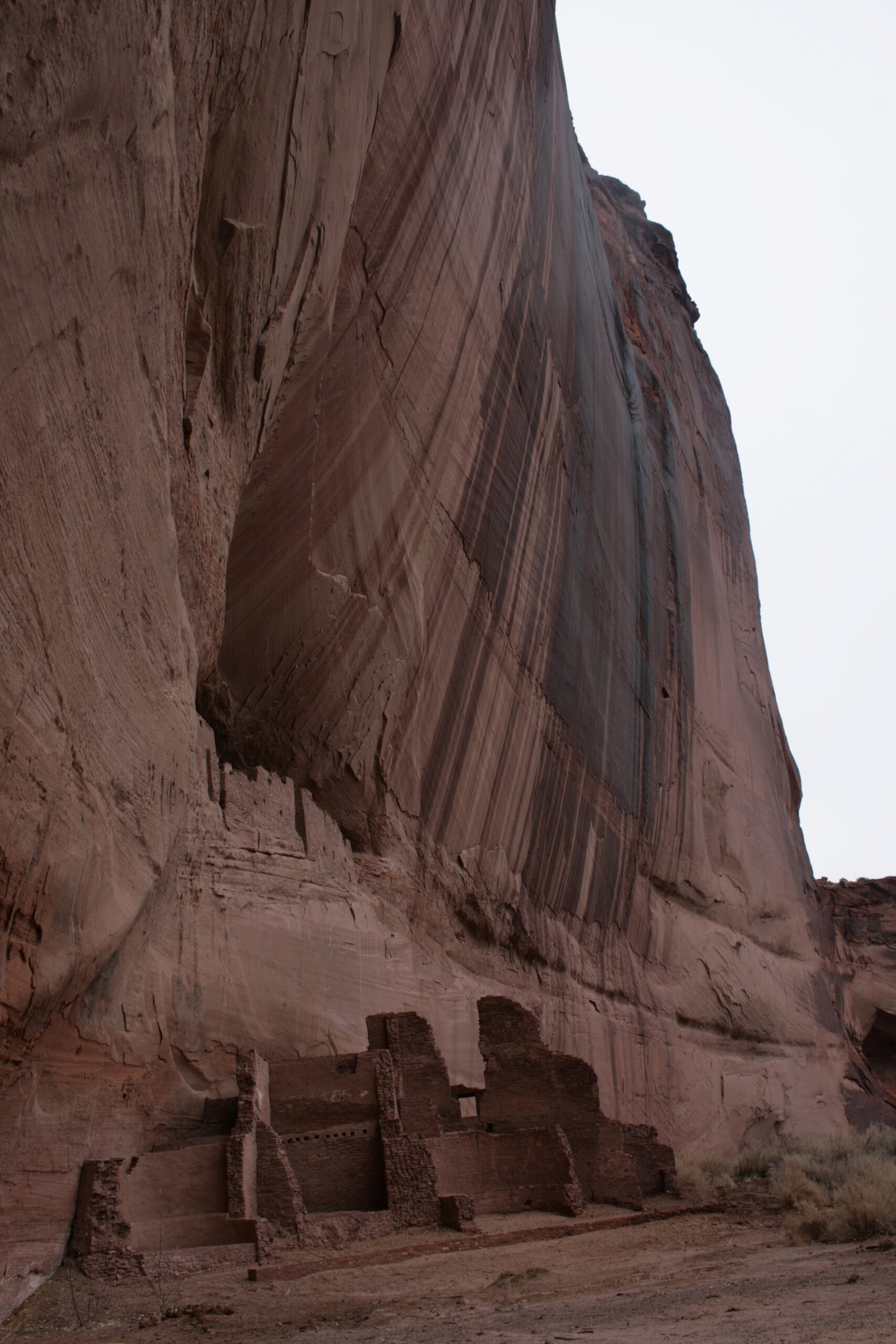
Ruins of an Anasazi cliff dwelling sit at the end of the White House Ruins Trail in Canyon de Chelly National Monument.
“The Park’s closed,” he explains. “Too much snow.” Doesn’t he know that we’re trying to fit a ten day road trip into four days, and we only have one day left to find out what happened to the Native Americans of the Four Corners? I think. He tells us that, if we’re lucky, the Park may open again the next morning.
“Quickly — to Hovenweep!” I urge my travel companions, hoping that we can squeeze yet another ruins site into our trip. As Rich drives away, Wendy programs the car’s GPS navigator to direct us to Hovenweep National Monument, the site of six prehistoric, Puebloan-era villages. Forty five minutes later, we find ourselves driving through rural prairies, near the intersection of Road P and Road 18, somewhere not at all close to Arrida, Colorado — which is to say — nowhere. In every direction, we see seemingly infinite swaths of snow fields. The blizzard, which had let up temporarily, starts again, slowly at first, then intensifies. We see no Puebloan villages. The snow makes me wonder whether the Hohokam, the Anasazi, and the Sinagua fled the area simply because they couldn’t handle the cold and crazy snowstorms. The car’s GPS navigator appears to have tired of sending us to the ruins of ancient civilizations. We’re lost. Rich stops the car on the side of the road.
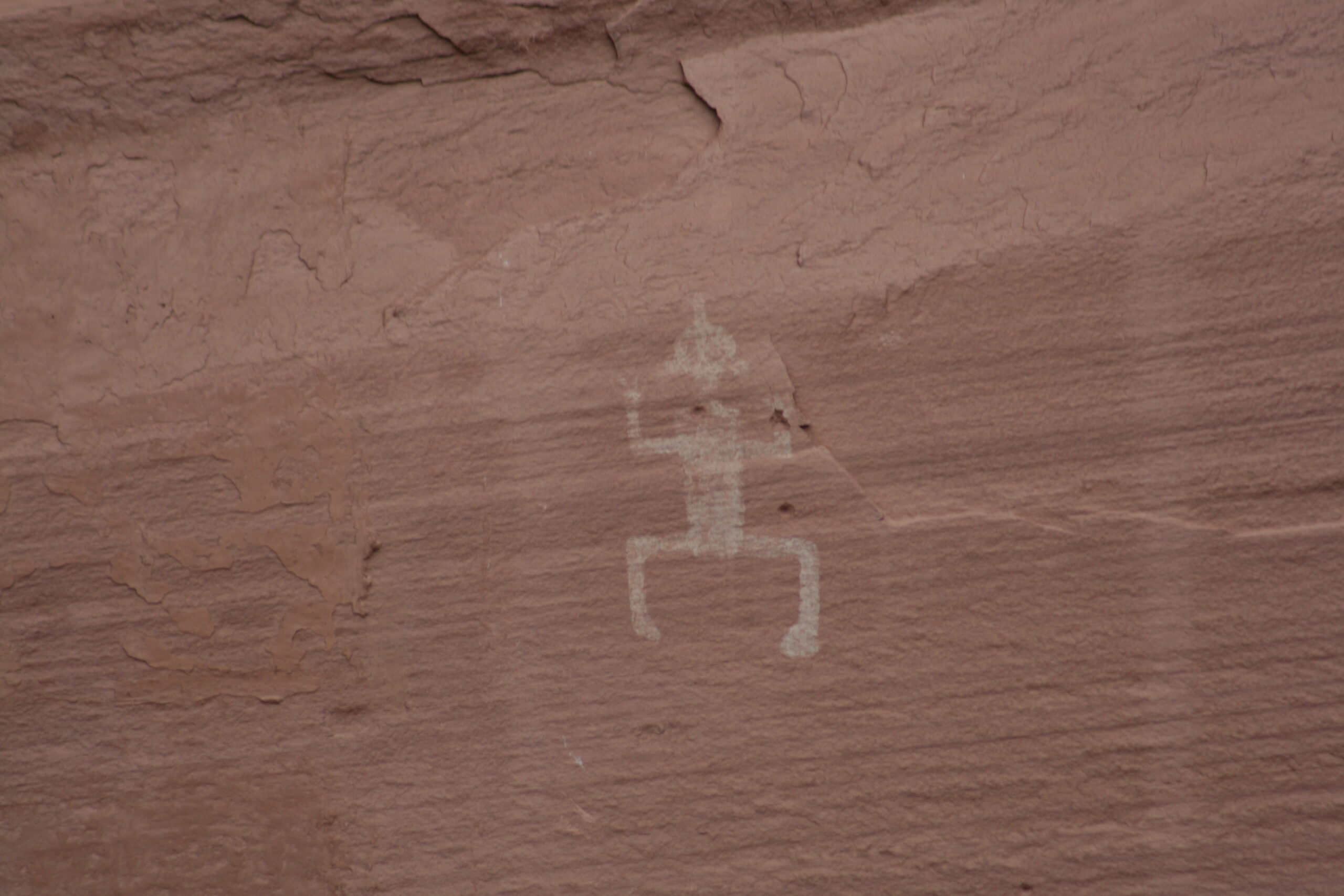
A pictograph appears on the White House Ruins in Canyon de Chelly.
“Snowhere,” Rich says. “We’re Snowhere.” Without explanation, he steps out of the car and starts walking slowly across one of the snow fields. Vik then gets out of the car too and follows him, about fifty feet behind. As Wendy and I watch, Vik bends down, builds a snowball in his hands, and pelts Rich in the back with it. When Wendy and I get out of the car, she too grabs some snow from the side of the road and then throws it at Vik when he’s not looking. I, the eternal travel documentarian, take photos until thousands of falling snow flakes render my camera inoperable. I pack it away, join the group, and start throwing snowballs at Rich.
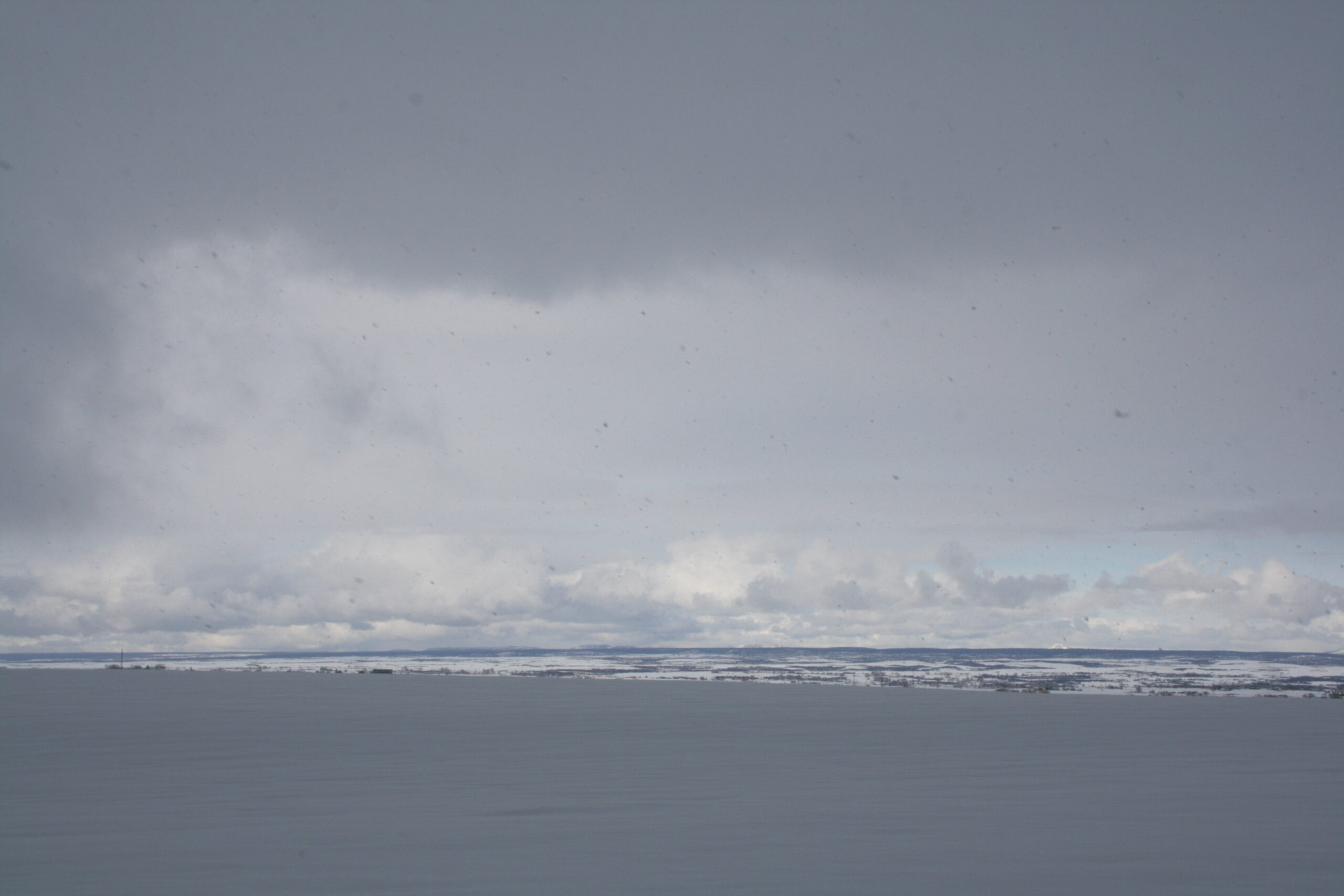
Snow covers the landscape near Cortez, Colorado during Snowpocalypse 2010.
Orbs of snow and ice fly chaotically through the air. One smashes into Rich’s shoulder. Vik’s jeans soon become soaked with snow. Wendy’s snowball weapons become the size of human heads. One bombards me in the neck.
My middle school teachers never would have allowed this, I think.
It’s an all-out snowmageddon. We never make it to Hovenweep.
A surreal, Native American dream
Tracking down vanished Indians in Mesa Verde National Park and Monument Valley.
FEBRUARY 23, 2010 — Drained from our snowball fight, Rich, Wendy, Vik, and I go to search for a place to eat in nearby Cortez. Almost all of the town’s restaurants are closed because it’s the afternoon of the Super Bowl and the blizzard has buried the roads in six inches of snow. Eventually, a sign reading “Big D’s BBQ,” outside a dilapidated building that looks like it might be the town jail, catches Rich’s eye, and he pulls the car into the parking lot.
“Really?” I ask.
“Local color,” he says.
We walk through a door labeled “Saloon” and discover that we’re some of the few non-Navajos inside a grungy dive bar. No one is eating any food.
“Where’s the barbecue?” I ask the bartender.
“Oh, the restaurant has been closed for months,” he tells me. “But we’re having a Super Bowl party right now; if you hang out to watch the game, you can enter our raffle to win a grill, and we’re having a free buffet with Navajo tacos at halftime.”
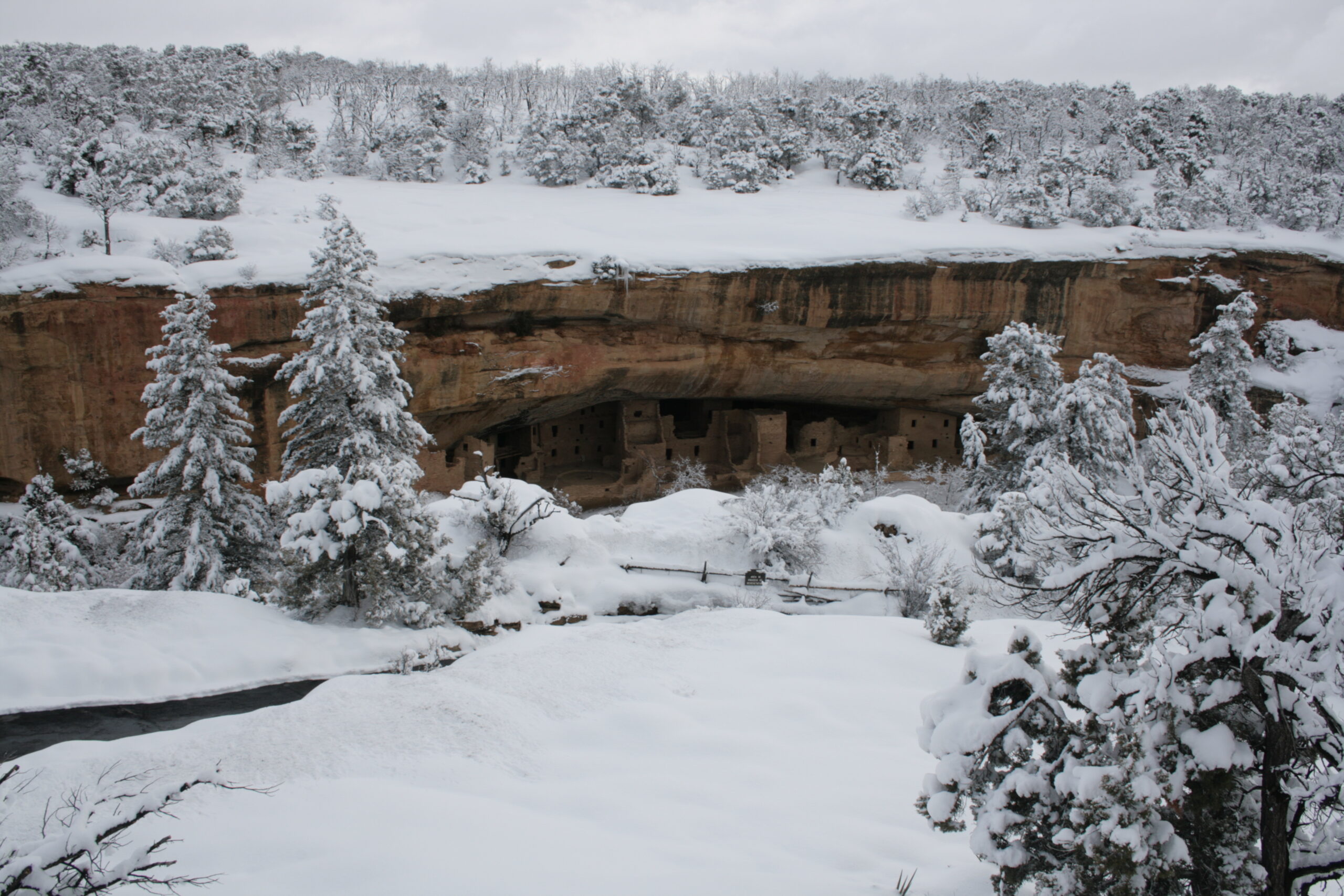
Spruce Tree House sits below a snow-covered cliff in Mesa Verde National Park.
We never turn down free Navajo tacos. Or, we never have before, since we have no idea what they are.
We’re gulping down glasses of Fat Tire and shoving Navajo tacos — which turn out to be traditional Native American frybread smothered in chili — into our mouths when, without warning, a shoe flies across the room, almost hitting Wendy in the head. We all turn around just in time to see a drunk woman grab a glass from the bar and chuck it as hard as she can at her boyfriend. It smashes into his chest with a loud thud, then clatters onto the floor. Apparently the shoe was meant for him as well.
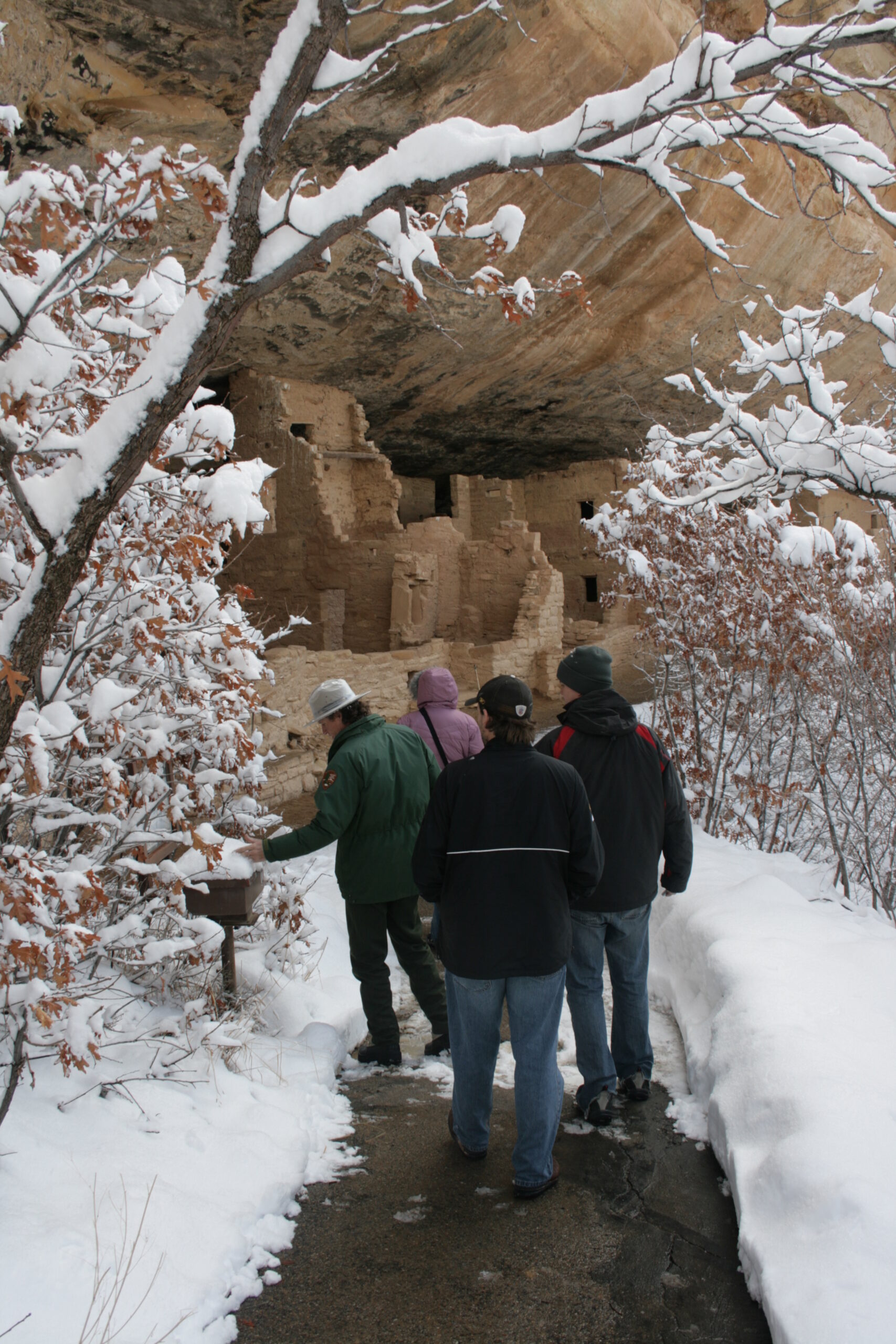
Ranger Craig guides Park visitors toward Spruce Tree House in Mesa Verde National Park.
“I think this local color may be our cue to leave,” Vik says, ducking under the table.
We hurry out of the bar, and after stopping at a store to buy more beer and a deck of cards, we pull into the parking lot of the Tomahawk Motel — which looks a lot like a snowboarding mogul park, due to the storm. Everyone waits in the car as I visit the motel’s office, where I see an enormous Great Dane, larger than me, sitting behind the desk.
“Are you the owner?” I ask the dog.
“I am,” the dog says. Actually, the voice turns out to be coming from a man who appears from a back room behind the human-sized canine.
“It’s cold out there, huh?” I say. The colossal dog looks at me suspiciously.
“Not really,” he says in a distinctly Scandanavian accent. The motel owner. Not the dog.
“Yeah, I guess you’re used to this,” I respond. “But that’s a lot of snow out there, huh?”
“Not really,” the owner says. Then, he rolls his eyes. The dog, I mean.
“Where are you from?” I ask.
“Here,” the owner says flatly. I give up.
I hand some money to the Great Dane, and then Rich, Wendy, Vik, and I move into our room at the Tomahawk Motel, waiting out Snowpocalypse 2010, drinking beer and playing Spades.

Sandstone bricks form the Spruce Tree House ruins in Mesa Verde National Park.
“Maybe I’ll never have to go back to work,” Wendy says hopefully. “Maybe the Snowpocalypse will trap us with oversized Great Danes in the Tomahawk Motel forever.”
But the next morning, snowplows have cleared the roads. I call Mesa Verde National Park on the phone, and a Ranger tells me that they’re open for business.
We meet Ranger Craig in the Park, who we’re pretty sure either smoked something illegal before arriving or is so entranced by his own Native American spirituality sermons that he can make himself high on demand. We’re disappointed to learn that beyond the normal winter-season closures of the Balcony House and Cliff Palace ruins sites, the Mesa Top Loop Road ruins viewpoints are closed because of the Snowpocalypse. But when Craig leads us down the Spruce Tree House path, past a forest of trees coated in white flakes, under a cliff blanketed with snow, to an expansive palace of ancient Anasazi homes, Mesa Verde feels like a dream.
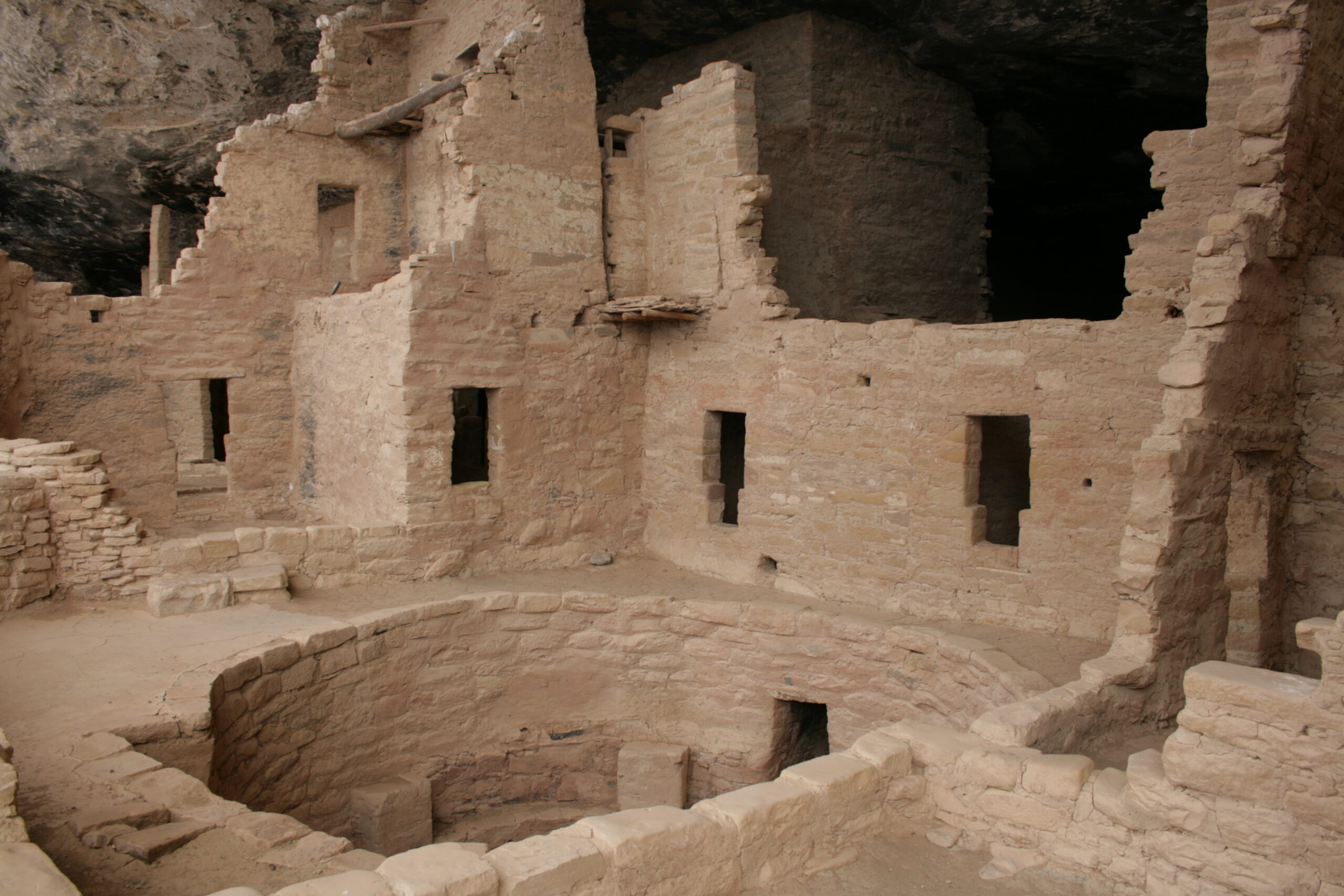
An uncovered kiva, a room used for ancient Native American religious ceremonies, in Spruce Tree House in Mesa Verde National Park
Craig adeptly takes over my role as middle school teacher. He pulls us all aside, away from the ruins, and tells us that the information he’s telling us is too sacred to discuss among the Puebloan homes. He tells us about Native American human remains that the Park reburied in a secret ritual in 2006. He tells us that some archeologists believe that the huge room hidden behind the palace served as a space for parties and dances, while others believe it may have been used for mysterious sacraments. He tells us about religious rituals that the Anasazi performed in kivas, round, underground rooms used for spiritual ceremonies.
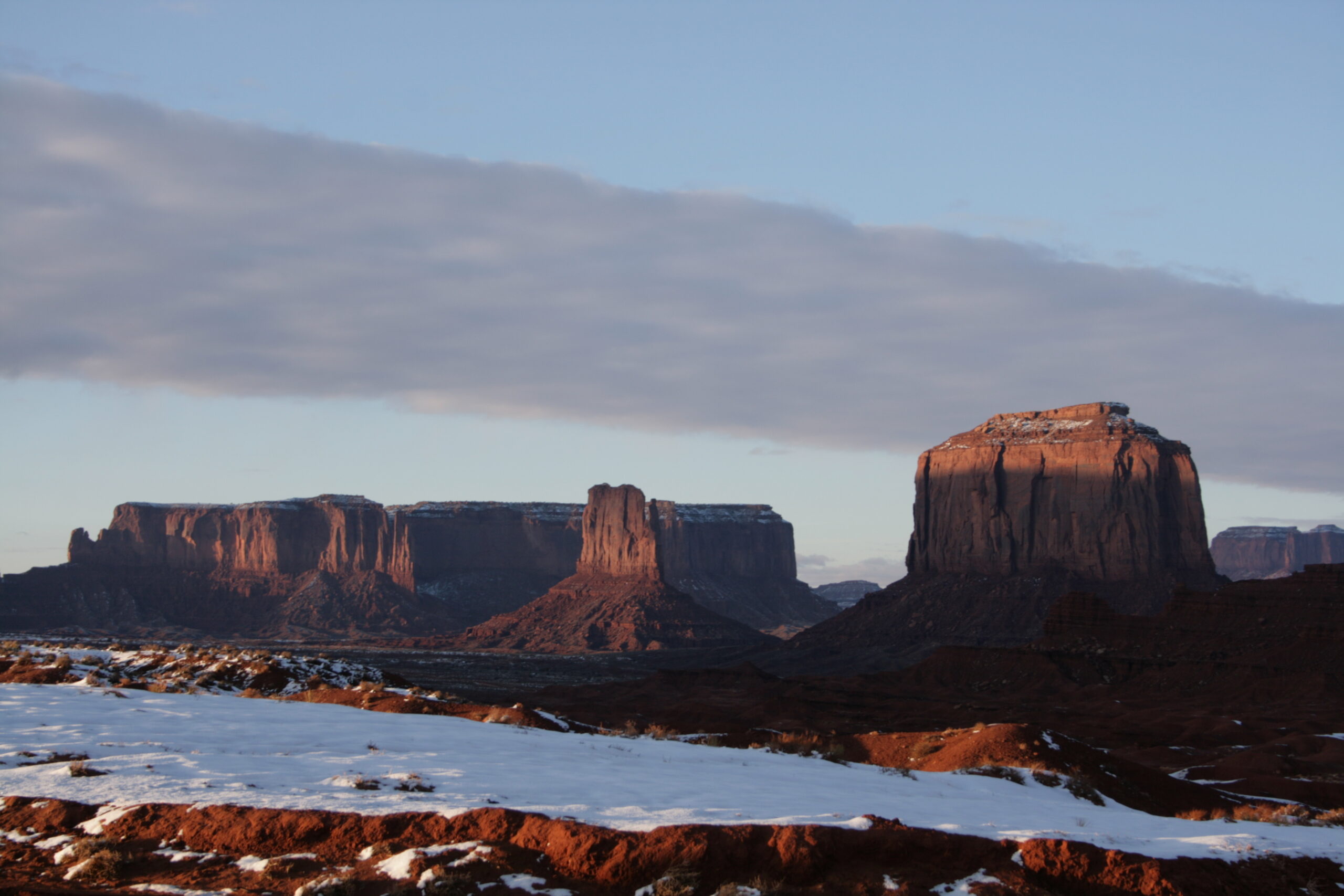
Monument Valley has appeared in numerous films, television shows, and commercials.
“You know that famous pictograph of Kokopelli, the Indian fertility deity, innocently playing a flute?” Craig asks. “That’s not a flute.” His wink and hand motion indicate that he’s referring to self-fellatio.
“You don’t get this info on the summer tour,” he says mischievously.
I pinch myself to try to wake myself up.
“He’s totally and completely high,” Wendy whispers to me. But I realize that this is probably my only chance to find out the answer to the biggest mystery of all.
“Can you tell us why the Anasazi left this place and disappeared?” I ask. I hope that maybe Craig will finally provide us with an answer, even if it’s drug-induced. He looks me right in the eye.
“No one knows,” he says mysteriously. He winks again. I stare at the sprawling cliff dwelling, disappointed.
After our tour, Rich chauffeurs us toward our final stop, Utah’s Monument Valley, a collection of sandstone buttes on Navajo land so stunningly beautiful that they have been used in hundreds of films, television shows, and car commercials. A dirt road in the Monument Valley Navajo Tribal Park lets adventurous drivers with high-clearance vehicles maneuver amongst the towering rock formations. But after traveling about a mile on the road, we reach a point at which the road surface has broken off. A small river flows in front of us, and deep mud is everywhere. Rich stops the car. We all look out of the front windshield at the fantastic rock formations of Monument Valley and the water blocking our way. Rich stares at the water. Wendy stares at the water. Vik stares at the water. We’re all silent. We sit there, motionless, for five minutes.

Rich steers our car through a muddy windshield in Monument Valley.
In my head, I’m screaming, “OMG. JUST DRIVE DOWN THE ROAD ALREADY!” but I’m not saying anything aloud, because I don’t want to be blamed when the car (owned by Rich and Wendy) gets stuck in a foot of mud and its transmission falls off. Rich is hesitant to take a risk. Vik’s primary concern is getting back to Los Angeles and his girlfriend, alive. Even adventurous Wendy’s number one priority is to protect the integrity of her car. We’re gridlocked.

A sign advertises Monument Valley tours near the Three Fingers rock formation.
“Hello,” an unexpected, gentle voice says through the front passenger’s window. “You can make it.” I see an old Navajo man with a ponytail and deep lines crisscrossing his aged face outside the car. This can’t be happening, I think. How long can this surreal Native American dream go on?
“Are you sure our car won’t get stuck?” Rich says.
“I’m sure,” the Navajo man says calmly.
“What if you’re wrong?” Rich asks him.
“I’ll save you,” he says in his soothing tone. Then, he gets into a nearby white van and drives away.
I’m about to ask everyone, half sarcastically and half seriously, whether they saw the Navajo man too, when Rich — the same guy who stayed behind while Wendy and I hiked along the perilous rim of Sycamore Canyon to the ruins — abruptly shifts the transmission into first gear and smashes down the accelerator. Mud flies everywhere, splattering the car’s windows. Wendy screams. Vik and I cheer and clap. My head hits the roof as the car hurls and bounces across the river in the road. Before we know it, we’re on the other side of the water, navigating through a half-foot of mud toward the magnificent Mitten Buttes. There, in Monument Valley, an enigmatic Navajo man somehow managed to give Rich the gift of courage.
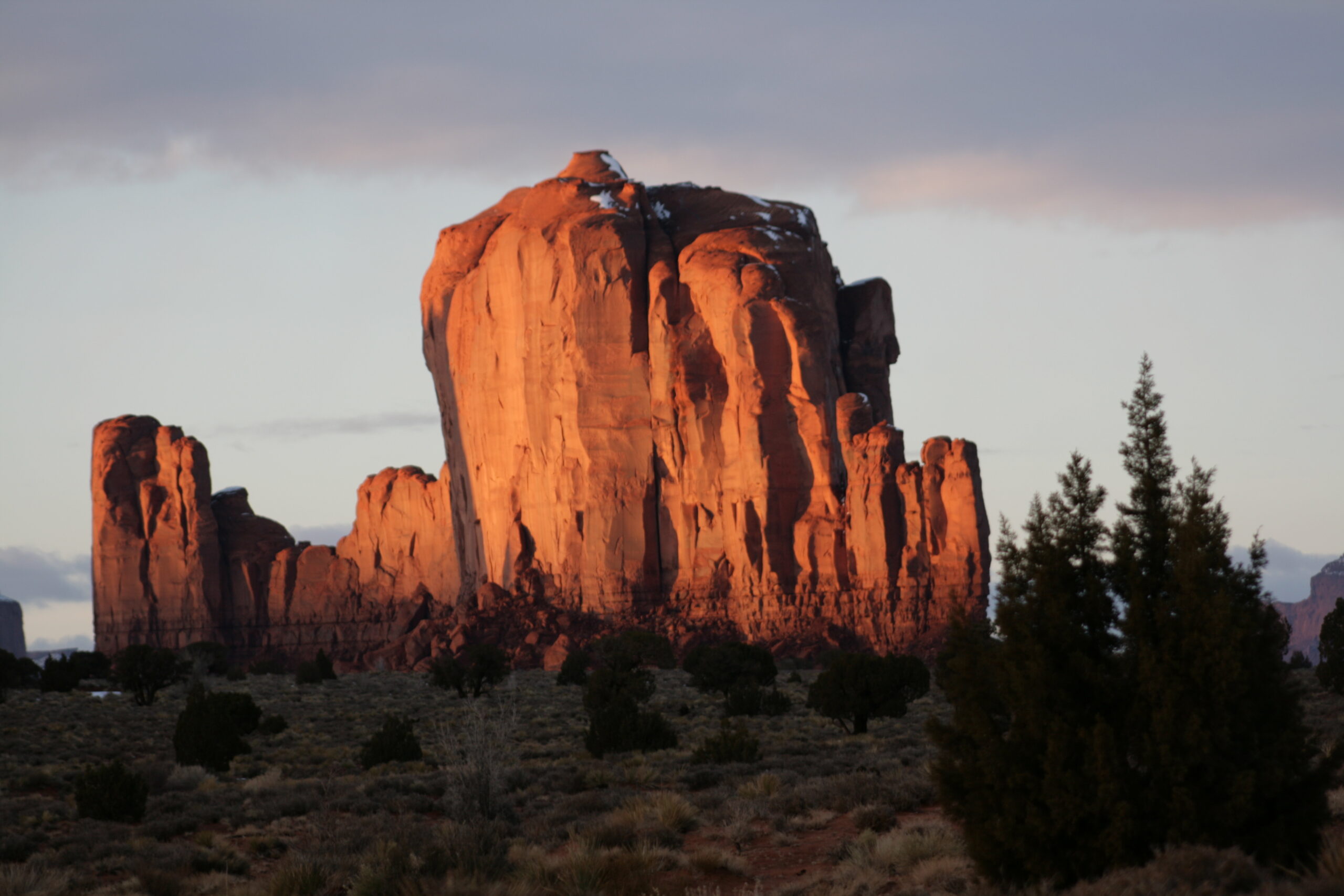
Sun reflects off a butte in Monument Valley.
As the sun sets, Rich continues to steer the car through the mud, weaving in out of the Valley’s towering buttes and plateaus. The golden sunlight reflecting off the red rock formations looks like a painting gifted to us by a higher power. The four of us get out of our car to soak in the panorama.
I realize that Monument Valley is our big finale. It’s our Grand River Day. I wish my middle school teachers were with us to see our fantastically improved “Indian Unit,” though I’m afraid they might be disappointed that I never solved the mystery of the vanished Native Americans.
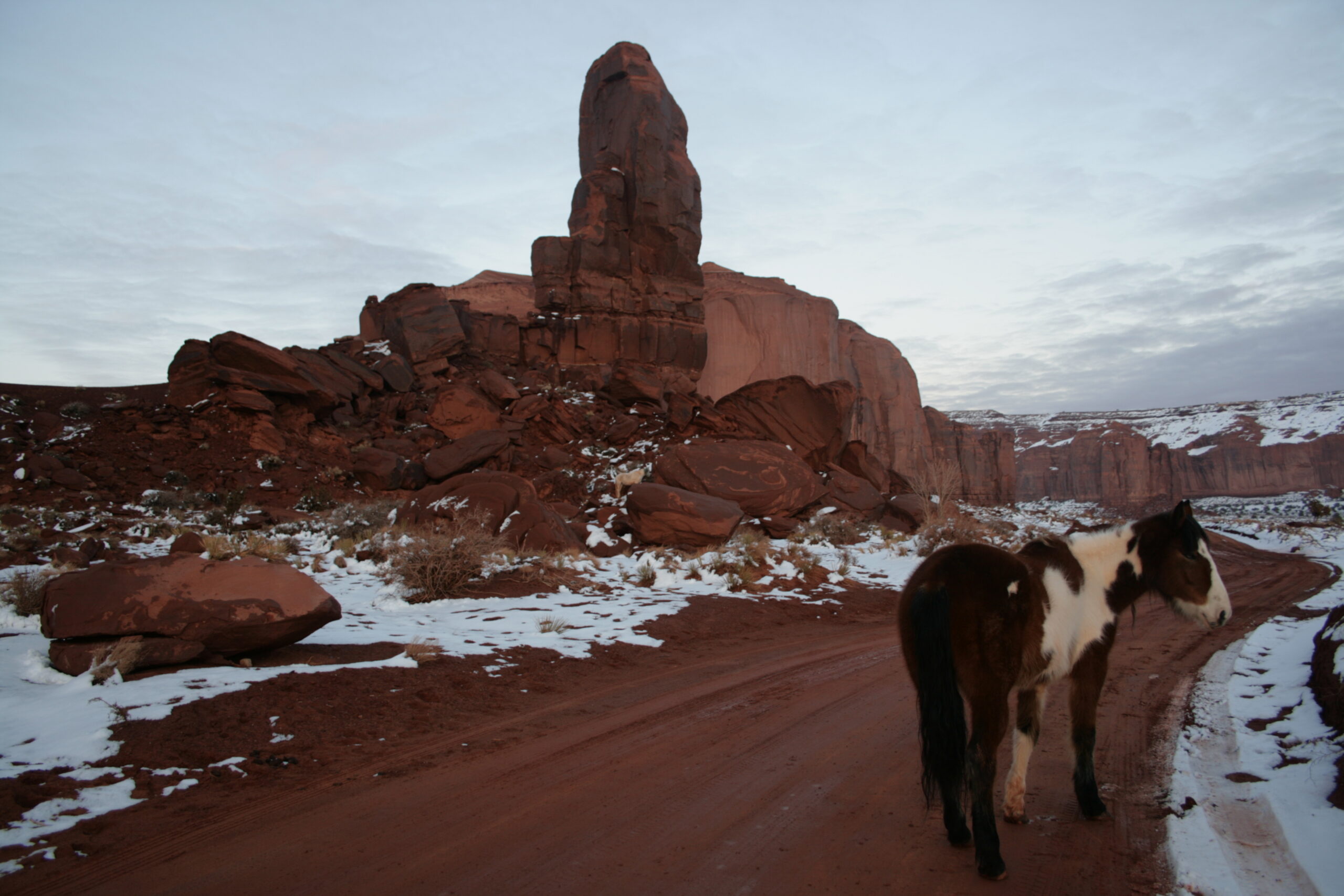
A horse appears in the middle of the road in Monument Valley near the Thumb on Camel Butte.
And then — and I promise I’m not making this up — a white and brown horse unexpectedly wanders into the road and stops in front of our car. I stare at it. Images from our trip flash through my head. I think of the wolfcow and shiny stallion from Sycamore Canyon, the oversized Great Dane from Cortez, and the mysterious Navajo man in Monument Valley who removed all of Rich’s anxieties. I try to make sense of them all.
Look, I’m not saying that the Hohokam, the Anasazi, and the Sinagua who disappeared from the Four Corners region 700 years ago became benevolent Navajo skinwalkers, appearing as cowwolves, horses, dogs, and old Native American guides, helping visitors to the area. That would be ridiculous.
But I don’t have any other explanation. And neither does anyone else.
How to Take an Indian Ruins Road Trip
There are thousands of Native American ruins sites in the American Southwest. Amateur archeologists could spend weeks exploring them all. Here’s a driving itinerary including some of the best. View this road trip on a map.
MONTEZUMA CASTLE NATIONAL MONUMENT: The Sinagua built this cliff dwelling, which, strangely, has (almost) nothing to do with the Aztec Montezuma. These ruins are impressive and easy to get to by walking a quarter-mile, paved loop. $5 per person.
PALATKI HERITAGE SITE AND HONANKI INDIAN RUINS: These two quarter-mile hikes near Sedona take hikers to the ruins of the largest cliff dwellings in Red Rock Country between 1150 and 1300 A.D.
CANYON DE CHELLY NATIONAL MONUMENT: Seeing this beautiful canyon will make you want to stay here forever. Unfortunately, due to a unique arrangement with the Navajo Nation, hiking or backpacking anywhere in the Monument requires a paid Navajo guide — except for the White House Ruins Trail, a 3.5-mile round trip hike into the Canyon to some impressive Anasazi ruins. Jeep and horseback riding tours are also available. View my hike on the White House Trail.
FOUR CORNERS: This is the point at which Utah, Arizona, New Mexico, and Colorado meet. Tourists pay $3 to stand on the exact intersection. I have no idea why anyone would want do this. We did it. You’ll do it too.
MESA VERDE NATIONAL PARK: This fantastic park, called an Archeological Disneyland by some, boasts some of the most notable and best-preserved cliff dwellings in the US. In the summer, take guided tours to Cliff Palace and Balcony House; during the winter, take a guided tour to Spruce Tree House. No matter when you go, drive the six-mile Mesa Top Loop Road to see ruins from lookout points and try one of the park’s hiking trails. $15 per vehicle in the summer; $10 per vehicle in the winter.
HOVENWEEP NATIONAL MONUMENT: This Monument allows visitors to see six prehistoric, Puebloan-era villages. $6 per vehicle.
MONUMENT VALLEY NAVAJO TRIBAL PARK: Drive this 17-mile dirt road loop to see the gorgeous buttes and plateaus of Monument Valley close up. A high clearance vehicle is recommended. Definitely worth the $5 per person, especially if you enjoy photography.
NAVAJO NATIONAL MONUMENT: See three Anecestral Puebloan cliff dwellings.
OFF THE BEATEN PATH: There are many Indian ruins sites outside National Parks and Monuments which can only be reached with help from Native American guides or enterprising hikers. Dave Wilson’s Hiking Ruins Seldom Seen helps amateur archeologists willing to hike long distances find some of these sites.
Hey Hank-
I somehow happened across your blog a while ago and I'm glad I checked in. I have to put my 2 cents in for the Gila Wilderness in NM (bit far for a road trip from LA but WORTH IT). The place is gloriously empty, and the ruins & hot springs beautiful. I had a fantastic time exploring the area on a bike trip, years ago. Silver City is a fun town, too. Put it on your list!
Remember when we went to see the new Indiana Jones? I don't think you want to be that version. Old and grey and slow on the feet. Though I bet even old Indiana Jones wouldn't fall into a purple cactus. Twice. 😉
I didn't feel jealous that I wasn't on this trip until now. I love snowball fights. I used to pelt people in the face at Northwestern. And by "people" I mean strangers.
Thanks for the advice, Sylvia! New Mexico is definitely on my list for an upcoming trip.
Stumbled upon your website while researching current snow conditions at the south rim (headed there this weekend, without snowshoes however). Your stories are very entertaining!
My husband and I live in Prescott, AZ (moved from MN five years ago) and go on mini trips as much as possible. This spring we are headed to Durango/Ouray and will be stopping at Mesa Verde National Park.
I'm (almost) convinced that your encounters with the dog, horse, Navajo man, etc. are signs of some kind. We've had similar things happen to us in our travels and lives also — kind of gives me chills.
Best of luck in your future travels.
Hank–glad to hear it!
I'm glad you like the site, Jan! Mesa Verde is an amazing place and it's definitely a great choice for a visit. All of the ruins sites are surprisingly large.
researching a late spring Indian Ruins road trip – loved your stories.
researching a late spring Indian Ruins road trip – loved your stories.
Great story and beautiful pictures, you truly have a gift for writing, I enjoyed reading about your adventures.
How do I find ppl/groups that do things like this (exploring ruins) in Texas. I love doing this but can't see finding anyone liking doing this…any ideas?